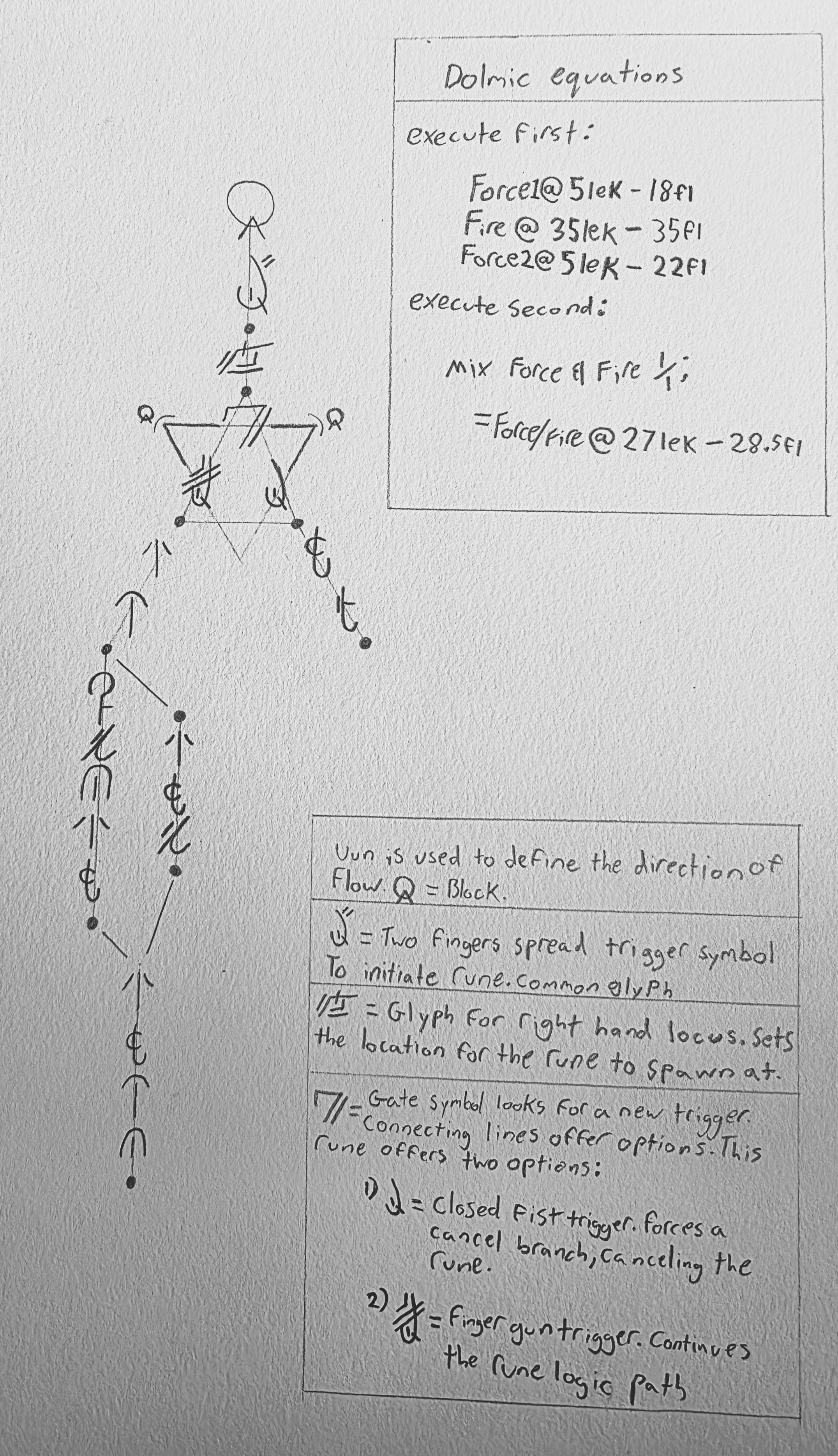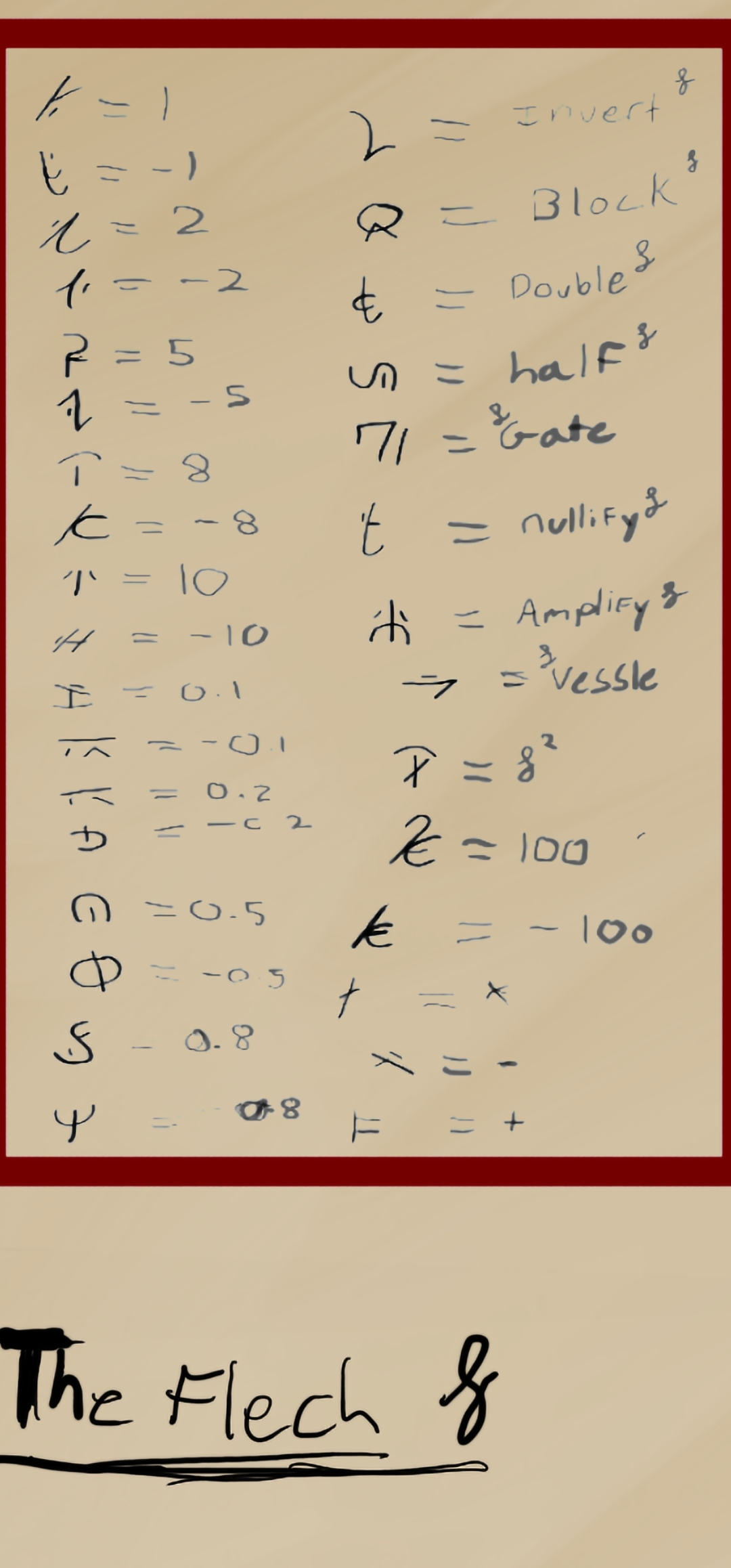¶ Runes and Natural Philosophy
A major field of magical practice is Natural Philosophy, which relies on the Dolmic Alphabet to form symbolic constructs—runes—that manipulate Aspects in a predictable and controlled way. The Dolmic Alphabet acts much like a logical language or algebra of magic, allowing for:
- Precision
- Repeatability
- Composability of complex magical effects
¶ Structure
A rune is constructed with various symbols representing verbs, subjects, and modifiers, and these symbols are painted using inks imbued with the relevant Aspects. For example:




A fireball rune might incorporate the Aspect of fire in the symbol dictating the flame’s nature.
Additional Aspects could include motion (to project it), explosion (to make it burst), or illumination (to make it glow).
Each part of the rune resonates with the Aspects in the ink, triggering a magical effect through structured symbolic resonance.

¶ Empowerment
¶ Empowering Aspects: Daions, Hexons, and DiHexan
¶ Daions
Daions are subatomic magical particles that act as the primary energy source for magic. They exist both inside and outside of all universes, permeating reality like photons in space. Each daion has a unique shape—a resonance signature that determines its magical behavior. While daions are generated naturally from the soul, much like a star emits photons, they do so at a much slower rate. When a daion reaches the end of its lifespan, it decays into an electron.
Daions are vital not just because they carry immense energy, but because this energy can be harnessed and merged with aspects to affect reality.
¶ Hexons
Hexons are the subatomic magical particles that constitute aspects. Like daions, each hexon has a specific shape that determines what aspect it represents—such as fire, growth, motion, or stone. Beyond simply defining the type of aspect, a hexon’s resonance also defines its position on a spectrum of potential—a conceptual axis determining how potent, reactive, or stable that specific instance of the aspect is.
¶ DiHexan
A DiHexan magical particle is created when a daion collides with and fuses to a hexon. The resulting DiHexan retains the shape (aspect identity) of the hexon but loses its original position on the potential spectrum. Instead, it becomes energized and actualized—a piece of living, resonating magic capable of affecting the world.
This energized particle is what actually enacts magical effects.
¶ Runes and DiHexan Function
When daions are pushed into a rune that has been inked with aspect-rich material, they merge with the hexons in the ink to form DiHexan particles. The rune’s geometry—especially when written using the Dolmic Alphabet—acts like a formula or program, informing the DiHexan particles how to align on the spectrum of potential. The net effect is a controlled magical output, such as a burst of fire or a shield of force.
The shape of the rune and the medium it’s written on (such as magically rich metals or enchanted parchment) heavily influence how DiHexan particles behave and how potent or stable the resulting magic will be.
¶ Runic symbology and Structure
¶ Fletch
Fletch is the unit of measument that is used to determine the resonant value of a DiHexan particle, also known as the "shape" of the aspect. Each base symbol in the Dolmic alphabet works as a standalone rune that will force DiHexan to resonate in a specific way, making for reliable and workable way to force aspect to behave in a dependable way.

When writing a rune, the Fletch value is compounding up until the point of consolidation, then is compounded on further with other aspects in the rune system. At the end point of the rune in a Natural Philosophy rune system, there is an aspect and resonance unique to that specific rune system, and the process is repeatable. For example:



- 'ALD' = 1
- 'EL' = 5
- 'AI' = 10
- 'ALD-EL-AI' = 1 + 5 + 10
so the combination of those three runes in a line (which would be a small rune system), the fletch value at the consolidation point would be '16fl'.
¶ Practitioner’s Guide: Constructing Rune Sequences
¶ The Rules
-
Sequential compounding: every rune modifies the running total so far.
-
Decimals compound too: decimal runes behave like any other—nothing is “sealed” mid-sequence.
-
No consecutive duplicates: never place the same rune twice in a row.
-
One consolidation only: the consolidation point * comes once, at the very end of the full equation.
-
Efficiency first: shortest, cleanest path to the exact Fletch target wins.
¶ Dolmic Runes & Values
Whole & medium steps
Ai = +10 
Gran = +8
El = +5 
Kir = +2
Ald = +1 
Negative mirrors
Ju = −10
Hun = −8
Fin = −5 
Dan = −2 
Ban = −1
Decimal chips
Ra = +0.8 
Essa = −0.8
Pan = +0.5
Kwey = −0.5
Nip = +0.2
Ond = −0.2
Lir = +0.1
Mah = −0.1
Operators / controls
Vo = double (×2 of the subtotal so far) 
Wei = half (÷2 of the subtotal so far)
Ta = invert (flip sign of subtotal)
Uun = block (flow/diode control in complex designs)
Esk = gate (conditional/triggering in complex designs)
Ey = nullify (true zero; resets subtotal—use with extreme care)
¶ Construction Method (repeatable)
-
Plan the exact target (e.g., 87.7).
-
Lay in decimals first so later steps don’t accidentally scale them.
Use the smallest set of non-repeating decimal chips to hit the fraction.
-
Build the integer using big/medium steps, alternating runes to avoid repeats.
-
Use Vo/Wei only by design (they scale the entire subtotal at that moment).
-
Place * once—at the very end—to lock the aspect’s Fletch.
¶ Decimal Cheat Sheet (minimal, no back-to-back repeats)
Positive
0.1 = Lir
0.2 = Nip
0.3 = Nip , Lir
0.4 = Pan , Mah (0.5 − 0.1)
0.5 = Pan
0.6 = Pan , Lir
0.7 = Pan , Nip
0.8 = Ra
0.9 = Ra , Lir
Negative
−0.1 = Mah
−0.2 = Ond
−0.3 = Ond , Mah
−0.4 = Kwey , Lir (−0.5 + 0.1)
−0.5 = Kwey
−0.6 = Essa , Nip (−0.8 + 0.2)
−0.7 = Kwey , Ond (−0.5 − 0.2)
−0.8 = Essa
−0.9 = Essa , Mah
Tip: If you must use Wei for +0.05, do it right at the start: Lir , Wei → 0.1 → 0.05; then only add.
¶ Worked Examples (all obey the rules)
A) 64.3 fl — decimals first, pure additive (stable, simple)
Sequence:
[ Nip , Lir , Ai , Gran , Ai , Gran , Ai , Gran , Ai , * ]
Trace: 0.2 → 0.3 → 10.3 → 18.3 → 28.3 → 36.3 → 46.3 → 54.3 → 64.3 → *
(No repeats; no scaling.)
B) 87.7 fl — efficient with interleaved Vo (few glyphs)
(Not decimals-first, but valid & efficient—your “Vo ladder” pattern.)
Sequence:
[ Ai , Vo , Ald , Vo , Ban , Vo , El , Pan , Nip , * ]
Trace: 10 → 20 → 21 → 42 → 41 → 82 → 87 → 87.5 → 87.7 → *
(All neighbors differ; Vo used intentionally.)
Conservative decimals-first alternative:
[ Pan , Nip , Ai , Gran , Ai , Gran , Ai , Gran , Ai , Gran , El , Ai , * ]
(0.7 then build +87 with alternating big steps; no repeats.)
C) 41.05 fl — using Wei correctly at the start
Sequence:
[ Lir , Wei , Ai , Gran , Ai , Gran , El , * ]
Trace: 0.1 → 0.05 → 10.05 → 18.05 → 28.05 → 36.05 → 41.05 → *
(Wei halves the subtotal right after 0.1; then only additive steps.)
D) 23.4 fl — ultra short
Sequence:
[ Pan , Mah , Ai , Gran , El , * ]
Trace: 0.5 − 0.1 = 0.4 → +10 = 10.4 → +8 = 18.4 → +5 = 23.4 → *
(No repeats; 5 glyphs + lock.)
¶ Patterns You Can Reuse
Interleaved-Vo ladder (efficiency):
Build subtotal fast with Vo, but always interleave small spacers:
… , Vo , Ald , Vo , Ban , Vo , …
Then trim with El/Kir/Ald and decimals.
Pure additive (control):
Alternate Ai and Gran, drop in El/Kir/Ald to hit the exact integer; finish with minimal decimal pair from the cheat sheet.
Half/Double trick (only if exact):
Build exactly half the target (including fraction), then a single Vo to land on the number. Never drop Wei/Vo mid-lane without expecting a rescale.
¶ Safety/Structure Reminders
Boundary circle: contains/insulates the working from ambient daions/aspects.
Initiation point: your entry; set direction of flow.
Connecting lines: optional regulators for large/branched systems.
One lock: place * once at the end of the lane to seal the Fletch.
No back-to-back glyphs: always interleave distinct runes.